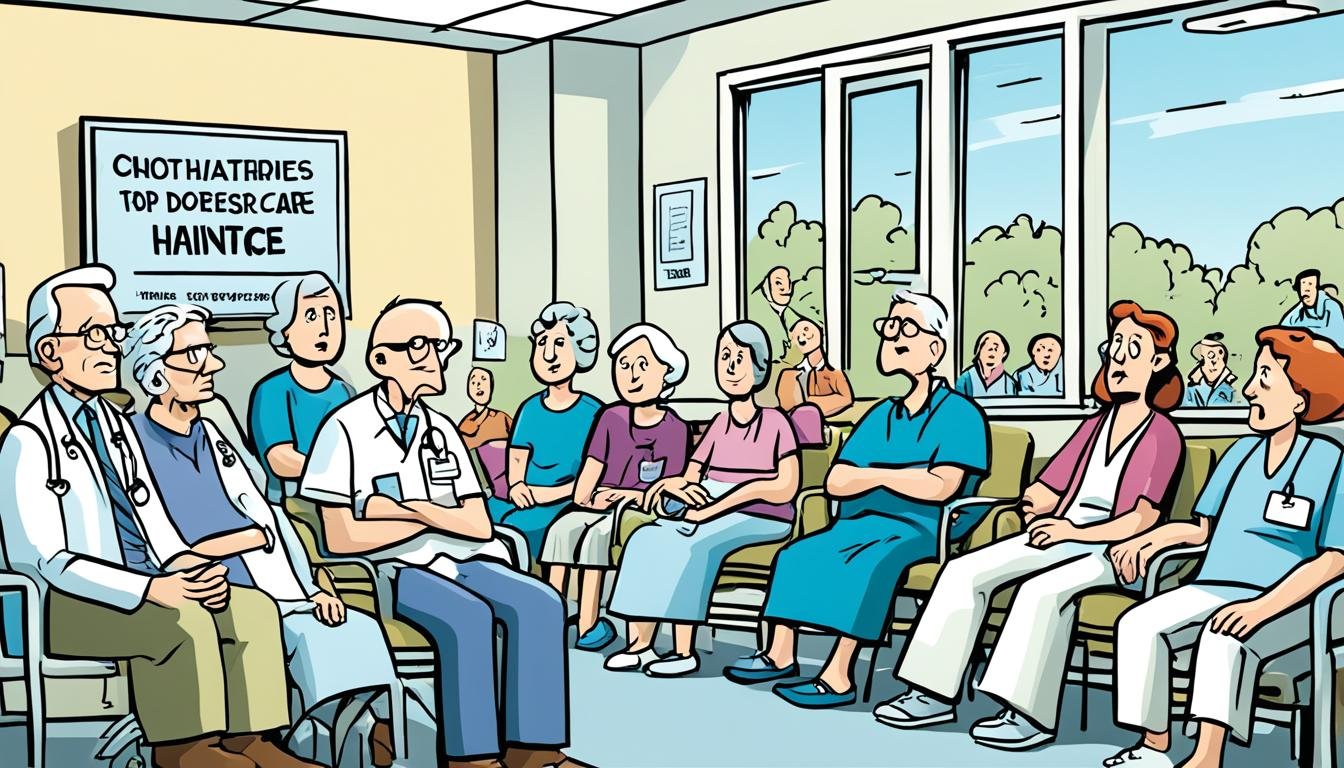Healthcare Policy and Political Challenges in Ireland
In 2015, Ireland spent a lot on healthcare, EUR 3,939 per person. This made up 7.8% of its GDP, more than the EU average. But, the 2008 financial crisis hit the healthcare hard, causing big cuts and longer waits for treatments.
Now, the Irish government aims for universal health insurance, starting with free primary care in 2015. But, making these big changes with a tight budget is tough. It shows how healthcare policy and politics are closely linked.
The 2008 crisis hit Ireland’s healthcare hard, making it harder to move forward. The push for universal health insurance is a big step, but it’s not easy. Ireland faces big challenges in balancing costs with keeping services good and accessible.
Key Takeaways
- Public expenditure cuts following the 2008 financial crisis severely impacted the Ireland healthcare system.
- The Irish government’s commitment to universal health insurance began with free primary care services by 2015.
- Implementation of major healthcare reforms is hindered by budget constraints and the need to balance cost savings with service quality.
- Long waiting times for publicly funded hospital treatments exemplify the ongoing challenges within the system.
- Efforts toward healthcare policy reform continue amidst a backdrop of financial and political complexities.
Introduction to Ireland’s Healthcare System
Ireland has a dual healthcare system. People can pick between public and private care. The public system is run by the Department of Health and the Health Service Executive (HSE). It offers a wide range of care, including acute, primary, continuing, and community care.
The 2023 healthcare budget is a record €23.4 billion. This money aims to give more GP care to nearly half of the population. It also focuses on women’s health, helping the elderly, and supporting people with disabilities.
Life expectancy in Ireland was 82.66 years in 2022, up by 0.18% from the year before. Spending on healthcare in 2022 was about €30.5 billion, a 6.6% increase from 2021. Even with this, healthcare spending was only 6.1% of the GDP, below the EU average.
The public healthcare system in Ireland has grown its workforce by over 2,400 people under the Sláintecare program. This shows Ireland’s dedication to creating a strong healthcare system for everyone.
In summary, Ireland’s healthcare system is improving with more money and new policies. These efforts aim to tackle big challenges and make the public healthcare better for everyone.
Historical Context of Healthcare Policy in Ireland
Ireland’s healthcare history is filled with key milestones that shape today’s system. These historical healthcare developments Ireland show how healthcare policy has changed over time.
Pre-2000 Developments
In the 1960s, *about 70%* of Ireland’s health spending went to hospitals. That year, health spending made up 2.9% of Ireland’s GNP, more than in France, Belgium, and the Netherlands. By 1965, 30% of people had a medical card for free primary care, and 90% got subsidized hospital care.
The healthcare system was heavily influenced by church-run institutions. This shows how Ireland’s social and religious background shaped healthcare.
- The first voluntary hospital in Dublin was established in 1718.
- The Voluntary Health Insurance Board was created in 1957 for the wealthy.
- Jonathan Swift highlighted the need for healthcare support in 1733.
The start of voluntary hospitals and the Voluntary Health Insurance Board showed early efforts to help all social classes with healthcare.
Post-2000 Transformations
After 2000, Ireland made big changes in healthcare to cover more people and improve care quality. The early 2000s saw a big change with the Health Service Executive (H.S.E) starting in 2005. This replaced the old Health Boards, making healthcare better organized.
The H.S.E was a big step forward. In 2015, Ireland changed a law to limit how religious hospitals could fire staff. Also, groups like the European Union and the World Health Organization started to guide Ireland on healthcare standards and preventing diseases.
Even with these steps forward, there are still challenges. The system is mostly paid for by taxes but people still pay a lot out-of-pocket, especially for primary care. With 45% of people using public healthcare, there’s a push to make healthcare both affordable and high-quality. The 2017 Sláintecare report talked about moving away from private care in public hospitals, showing a plan for better, fair healthcare for everyone.
The Impact of the Financial Crisis on Healthcare
The 2008 financial crisis hit Ireland hard, causing a 9% drop in public health spending. This big cut in funding led the Irish Government to make tough choices. They had to manage the healthcare sector’s financial gap through austerity.
One key move was cutting healthcare budgets in many areas. These cuts lowered costs on medicines and staff. Even so, the government started a “money follows the patient” system to make hospitals work better.
But, these cuts brought big challenges. Keeping healthcare quality up was hard with the ongoing economic worries. The Irish healthcare system was already short on funds for years. From 2009 to 2013, the Health Service Executive (HSE) lost almost €3.3 billion in public money. Staff numbers also fell by 10% from 2007, making things even tougher.
Looking at the big picture, in 2012, healthcare spending was only 8.1% of Ireland’s GDP. This was less than the OECD average of 8.9%. It shows how underfunded healthcare was and the big effect of the economic crisis.
In 2011, the Irish Government planned big health reforms. They wanted to create a single-tier health system. These changes were key to dealing with the economic crisis’s healthcare effects. But, the cuts showed the tough balance between saving money and keeping healthcare quality.
Understanding how the economic crisis affected Ireland’s healthcare shows the wider issue of financial limits on public health worldwide. It points out the need for strong healthcare systems that can handle economic ups and downs.
Healthcare Funding: Current Allocations and Challenges
Managing the healthcare budget in Ireland has been tough lately. The main issues include rising drug costs and the effect of more older people. Even with more money, Ireland finds it hard to make healthcare better without spending too much.
The new Population-Based Resource Allocation (PBRA) model is changing how Ireland funds healthcare. This model spreads healthcare money based on what people need. It will start in 2024, along with new Regional Health Areas (RHAs), to make hospitals and community care work better together.
Looking at how other countries like Alberta, Canada, and England handle PBRA has been helpful. The Central Statistics Office and ‘Healthy Ireland’ Surveys will guide Ireland’s PBRA. This will help tackle the big challenges in funding healthcare.
But, there are still big hurdles. For example, not having a unique health ID makes it hard to track costs for different groups of people. Using data on demographics, economic status, and health use will help make the PBRA model better.
The Department of Health has given the Health Research Board more money, 7.6% more for 2022. This shows a strong commitment to important research areas like health studies and aging well.
As Ireland moves towards universal healthcare, the Department of Health focuses on research that helps with policy and teamwork. Even with big efforts, the healthcare budget in Ireland is still linked to future policies and solving funding issues.
Universal Healthcare Coverage Goals
The goal for universal healthcare in Ireland is to make sure every citizen can get quality medical care. This dream is shown in the Sláintecare report from 2017. It presents a plan for a public healthcare system for everyone.
Sláintecare Initiatives
Sláintecare wants to change Ireland’s healthcare by merging the private and public sectors. It plans to increase spending on public healthcare. The main steps include:
- Introducing universal GP and primary care access
- Eliminating private practice in public hospitals
- Reducing or removing out-of-pocket fees
These big goals help move Ireland towards universal healthcare. They show a strong promise to make healthcare available to everyone.
Challenges to Implementing Universal Coverage
Even though Sláintecare is a forward-thinking plan, it faces big hurdles. Money issues slow down changes. Old habits and policies also make it hard to move forward. Plus, private health insurance in Ireland is much bigger than in other places.
But, Sláintecare has already made some good steps. For example, it lowered costs for kids and hired more healthcare workers. With more effort, Ireland can get closer to universal healthcare and better healthcare for everyone.
Government Regulations and Reforms
Government rules and changes in Ireland’s healthcare aim to make the system better and more efficient. They focus on cutting costs to deal with financial issues. This includes changes in how money is spent on healthcare.
Reforms have looked at staff and medicines to spend less but better. Payment systems have also changed to use funds wisely. This is because Ireland’s population, now over 4.76 million, is growing.
The Public Service Reform Plan 2014-2016 aimed to improve services for the public. It involved about 307,000 public workers. Yet, making healthcare rules work is hard due to delays and gaps in action. The number of people with medical cards has gone up by 25% since 2008, making things more complex.
There’s a big need to improve mental health services because more people need them. Some groups, like those in the criminal justice system, don’t get the same access. This shows we need better ways to deliver services. The Inspector of Mental Health Services has pointed out these issues, calling for changes.
To make healthcare fair and effective, Ireland must tackle these issues carefully. It’s important to build trust in public services, which is currently below the European average. This trust is key to making healthcare work well for everyone.
Healthcare Accessibility and Equity
Ireland’s healthcare system has both public and private parts, which creates challenges in healthcare fairness and access. Those who can pay for private insurance get care faster than those using public services. There are ongoing efforts to fix these issues and make healthcare more accessible to everyone.
Public vs Private Healthcare
The fight between public and private healthcare in Ireland is big. The “The Utilisation of GP Services” study by Nolan, A. & Nolan, B. shows a big gap in using general practitioner services. People with private insurance get to see doctors sooner, which means they get better health care.
But, a study by O’Reilly, D. et al. in 2007 found that high costs stop many from seeing doctors. This makes healthcare unfair in Ireland.
A study by Smith, S. also showed that emergency rooms are more crowded with those using public healthcare. This shows that public patients don’t get care as quickly, which is a big problem.
Efforts to Improve Accessibility
To make healthcare better, big steps have been taken. More services are now in the community and for mental health. This helps ease the load on hospitals and gives quicker care.
Also, there’s more money going into making hospital care better. This includes cutting down wait times and making services better.
The Central Statistics Office (2007) says these changes and more money for healthcare are key to making healthcare fairer in Ireland. Even with progress, more work and big policies are needed for a fair healthcare system.
Patient Rights in Ireland
The idea of patient rights in Ireland is key to the country’s healthcare. It makes sure people are treated with respect and get the health care they need. Patients get quick access to health services, learn about their treatment choices, and can make their own care decisions.
Looking at healthcare entitlements in Ireland, we see laws that protect these rights. These laws help patients get top-quality services fast. But, sometimes, not enough money and slow systems make it hard to achieve this goal.
To fix these problems, efforts are underway to make things run smoother and give patients better access to care. The Sláintecare program shows the government’s effort to improve healthcare and make it fair for everyone.
Also, getting the public and patients involved in research is important for making healthcare better. Reports like “National Institute for Intellectual Disability, All we Want to Say” and “Service User Involvement Methods Guidance Document” from the Health Service Executive share what different patients need and feel.
In the end, even with challenges, efforts and changes are making patient rights and healthcare access better in Ireland. With ongoing improvements and dedication, Ireland’s healthcare aims to give everyone equal and reachable healthcare.
Evaluation of Healthcare System Performance
Looking at Ireland’s health system, we see how well services work and how happy people are with their healthcare. Sláintecare is a big plan to fix problems and make healthcare better for everyone.
Service Quality and Efficiency
Ireland’s healthcare service has been getting better over time. In the past two years, many important policy documents were made. These show a big push to make things better.
During the COVID-19 pandemic, the economic hit was big but not as bad as expected. This let the government make big changes to the healthcare system.
- Telemedicine became very popular, showing new ways to care for people with less money.
- A special fund of €435 million was set up to help with health challenges during the pandemic.
- By May 2021, efforts to fix problems from COVID-19 included smart use of resources and vaccination.
Public Satisfaction and Feedback
People in Ireland have mixed feelings about their healthcare. From 2018 to 2023, some big issues were found:
- There were problems with being open and accountable in the system.
- There wasn’t enough money to make reforms work well.
Even with these problems, Ireland still wants to give everyone access to healthcare. The Sláintecare reforms aim to improve services and make care fairer. Fixing these issues is key to making Ireland’s healthcare better and making people happier with their care.
Political Landscape Influencing Healthcare Policy
In Ireland, politics greatly affects healthcare policy. Different political parties help shape and carry out healthcare policies. This leads to big changes in laws and services.
Role of Political Parties
Ireland’s political parties play a big part in making healthcare policies. Their plans and government actions set the stage for healthcare changes. For example, the Public Health (Alcohol) Bill passed in 2018 shows how party goals and groups can push for change.
Changing healthcare policies also means building political agreements. The Multiple Streams Approach (MSA) shows how parties and groups work together. They aim to solve big health issues like alcohol abuse, which is a big problem in Ireland.
Public Policy Implementation
Putting healthcare policies into action in Ireland needs teamwork. It takes coordination among many groups, including doctors and health advocates. About 11 departments deal with alcohol issues, showing how complex policy making can be.
The Advocacy Coalition Framework (ACF) shows how working together can lead to policy changes. Ireland’s efforts to reduce alcohol harm led to strong rules on alcohol sales and marketing in 2018. Politicians, advisors, and health experts worked together to make it happen.
So, politics is key in shaping and putting healthcare policies into action in Ireland. Knowing how political parties and policy making work helps us see what the future of Ireland’s healthcare might look like.
Future Prospects for Healthcare Reform
The future of healthcare in Ireland looks bright, thanks to the Sláintecare plan. This 10-year plan aims for universal coverage and equal access to services. It’s set to change the health system for the better.
With over 22,000 new healthcare workers, including 6,500 nurses and midwives, and 3,000 health professionals, the stage is set for success. This growth will support the healthcare reforms.
The population of Ireland has grown by 7.6% since the last census, reaching 5.1 million in 2022. It’s expected to keep growing. With more people, especially older ones, needing healthcare, the need for reform is clear.
Economic and political changes will affect Ireland’s healthcare plans. The government has made healthcare more accessible by removing inpatient charges and offering free contraception to women under 30. They’ve also made GP care free for kids and low-income families.
The Department of Health has set priorities for 2023-2025. These include preparing for pandemics and making healthcare fairer and faster. The goal is to create a health system that can handle future challenges.
Politics plays a big role in shaping Ireland’s health policy. It’s important to work together and advocate for effective policies. New laws and health boards are being set up to support lasting healthcare reform.
Ireland has shown strong leadership in handling the COVID-19 pandemic. This shows a commitment to a resilient health system. To achieve universal coverage and equity, ongoing government support and strong public health policies are key.
Conclusion
Ireland’s healthcare reform is a story of hope and hard work. The country aims to give everyone quality healthcare, despite tough challenges. It has made big steps in making healthcare better and more focused on patients.
Universal healthcare goals, like Sláintecare, show Ireland’s strong will to care for its people. But, this path is not easy. It must balance public and private healthcare and deal with big economic issues like the global financial crisis and COVID-19.
Still, the effort from everyone involved is key to moving forward. The main takeaway is that we need to keep working hard and finding new ways to improve healthcare. By using lessons from around the world and building strong health systems, Ireland can get better at public health. This will help tackle any areas that need work to make healthcare even better.
Source Links
- Improving access to healthcare in Ireland: an implementation failure | Health Economics, Policy and Law | Cambridge Core
- Ireland – Healthcare
- The impact of the crisis on the health system and health in Ireland – Economic crisis, health systems and health in Europe
- A brief history of healthcare in Ireland
- The Irish Healthcare System
- The impact of the financial crisis on the health system and health in Ireland
- Health Care for All in Ireland? The Consequences of Politics for Health Policy
- Implications for health system reform, workforce recovery and rebuilding in the context of the Great Recession and COVID-19: a case study of workforce trends in Ireland 2008–2021
- Sláintecare implementation status in 2020: Limited progress with entitlement expansion
- TOWARDS UNIVERSAL HEALTHCARE IN IRELAND – WHAT CAN WE LEARN FROM THE LITERATURE?
- Ireland – United States Department of State
- Equity in health care: the Irish perspective | Health Economics, Policy and Law | Cambridge Core
- Microsoft Word – WP 14 Ireland’s Health System BN AN.doc
- The public and patient involvement imperative in Ireland: Building on policy drivers
- Coordination, framing and innovation: the political sophistication of public health advocates in Ireland
- Building health system resilience through policy development in response to COVID-19 in Ireland: From shock to reform
- The role of governance in shaping health system reform: a case study of the design and implementation of new health regions in Ireland, 2018–2023 – BMC Health Services Research
- Waiting for the wave: Political leadership, policy windows, and alcohol policy change in Ireland
- Collaborating on Healthcare on an All-Island Basis: A Scoping
Study - Department of Health OGP Annual Report 2022
- The Challenge of Healthcare Reform
- A novel approach to utilizing the essential public health functions in Ireland’s health system recovery and reform
- Reframing health and health policy in Ireland








